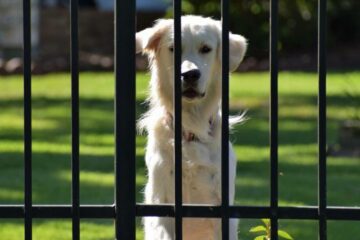Are Voles Dangerous to Dogs? My Dog Ate a Vole!
Are voles dangerous to dogs? And what do you do if your dog ate a vole? In this article, we’ll answer everything you need to know about both of these questions. That includes teaching you not just what to do right away, but also an easy command you can use to ensure this never happens again!
We’ll then fill out your knowledge by instructing you on where voles are found, what voles look like, and even what vole holes look like too! Finally, we’ll finish by helping you learn how to get rid of voles naturally so that you can quit having your yard ruined without risking your dog’s safety. Keep reading!
Are Voles Dangerous to Dogs?

Voles are not dangerous to dogs. These small, burrowing rodents are more of a danger to your garden than to your pet. However, voles can carry diseases that may be harmful if your dog comes into direct contact with them or their droppings. Teaching your dog to stay away from these creatures, especially using commands like “leave it,” can help prevent any potential health issues.
Can a Vole Hurt My Dog?
While voles are not typically aggressive, they can bite or scratch if threatened or handled, which can potentially injure your dog. However, the primary concern with dogs and voles is not the voles themselves, but the parasites and diseases they may carry. Voles can harbor ticks, fleas, and mites, which can infest your dog and lead to other health problems.
What Diseases Do Voles Carry?
Voles are known to carry a variety of parasites and diseases that can potentially affect dogs, including Hantavirus, Lyme disease, and tularemia. These diseases can be transmitted through direct contact with a vole or its droppings, or indirectly via ticks or fleas that have fed on an infected vole.
While these diseases are rare, it’s important to take preventative measures, especially if voles are known to inhabit your area.
Training the “Leave It” Command
One of the best ways to keep your dog safe from voles and other potential dangers is by teaching them the “leave it” command. Here’s a basic guide on how to train this command:
- Begin with a treat in both hands. Close one hand and let your dog sniff it, saying “leave it.”
- Once your dog stops trying to get the treat and pulls away, say “good” or “yes,” and give them a treat from the other hand.
- Repeat this process until your dog moves away from the first hand when you say “leave it.”
- Next, place a treat on the floor, covering it with your hand. Say “leave it,” and reward your dog with a treat from your other hand when they obey.
- Gradually make the task harder by leaving the treat uncovered, or using a favorite toy instead of a treat. Always reward your dog for listening to the command.
These steps will get your dog to stop eating voles or bothering them, but it’s important to remember that the underlying behavioral issues (prey drive, curiosity, overexcitement, etc.) that were causing all of this to begin with will still be present. And until you address those, any positive changes you see are only going to be temporary.
“Well, how do I make these changes last?”
By getting your dog to truly choose to follow your direction, that’s how. I tried many times to write out how you can do that before deciding it made more sense to just link you to the free video series that explains it better than I’d ever be able to.
The series is by a man named Dan who is one of the world’s leading dog obedience trainers. In it, he teaches you how to put an end to things like when your dog eats voles and all other misbehavior using his fast and easy-to-follow methods.
In the first video, Dan will reveal to you why the two most common methods of dog training only doom you to failure. You can watch the video now by clicking here. Follow the proven system he’ll show you in his series and you’ll never have to spend another second worrying about your dog eating voles ever again!
My Dog Ate a Vole

If your dog ate a vole, there’s generally no immediate cause for panic. Dogs are natural predators and their systems are designed to handle raw food. However, voles can carry parasites and diseases that could potentially pose a threat to your dog. Therefore, it’s important to monitor your pet for any symptoms of illness and contact your vet if you notice anything unusual.
What to Do
The first step if your dog ate a vole is not to panic. However, it’s important that you keep an eye on your dog for any signs of illness in the following days or weeks. Symptoms may include lethargy, loss of appetite, vomiting, diarrhea, or changes in behavior. If you notice any of these signs, or if your dog appears unwell, contact your vet immediately.
If possible, try to safely secure a portion or sample of the vole. This can potentially assist your vet in determining if the vole was carrying any diseases or parasites that could affect your dog.
My Dog Killed a Vole
If your dog killed a vole, it’s important to remove your pet from the situation and secure the area to prevent further interaction. Try to remove the carcass with gloves to avoid any direct contact. Remember, voles can carry diseases and parasites, and even handling a deceased vole can pose health risks.
Additionally, use this situation as a learning opportunity to reinforce training commands, such as “leave it.” We explain how to do this in the first section. Preventative measures like this can help protect your dog from potential risks associated with hunting, attacking, and eating small creatures like voles.
Preventing Future Incidents
It’s important to take steps to discourage your dog eating voles or hunting them. Maintain close supervision during outdoor activities, especially in areas where voles may be present. Regular flea and tick prevention is also important, as these parasites can transmit diseases from voles to dogs.
Finally, reinforcing training commands can help manage your dog’s instincts and keep them safe. Learn the “leave it” command in the first section.
You’ll want to get this issue handled now as it will also keep your dog safe in other potential future encounters. You’ll then have no worries about the possibility of your dog eating moles, your dog eating gophers, or your dog eating groundhogs if they come across one as you’ll know your pet will behave properly.
What Do Voles Look Like?

Voles, often mistaken for other small mammals, are rodents with compact bodies, short legs, and short tails. They have small eyes and ears that are partially hidden by their fur. While their exact appearance can vary depending on the species, understanding these basic traits can help identify them.
What Does a Vole Look Like?
A typical vole is about 5 to 8 inches long, including its short tail. They have stout bodies with fur that ranges from light brown to grayish-black. Their underbellies are usually lighter, often gray or white. Voles have rounded muzzles with small ears and eyes — characteristics that differentiate them from mice and rats. They also have large front teeth for gnawing, similar to other rodents.
What Do Vole Holes Look Like?
Voles create burrow systems that can be identified by the presence of small holes in the ground, typically about 1-2 inches in diameter. These holes often appear in yards or fields and can be distinguished from other rodent holes by the absence of piled soil at the entrance.
Instead, you’ll notice a well-worn, visible path or “runway” leading to and from the hole, as voles frequently reuse the same routes.
Where Are Voles Found?
Voles are widespread and can be found across North America, Europe, and Asia. They inhabit a variety of environments, including grasslands, woodlands, and even suburban areas. In residential settings, they’re often found in gardens or lawns, where they burrow and create runways under the cover of tall grass or mulch.
Noticing these signs can help identify the presence of voles and allow you to take appropriate measures if needed.
How to Get Rid of Voles Naturally
To get rid of voles naturally, use a multi-pronged approach involving habitat modification, natural repellents, plant selection, and introducing predators. These methods, while safe for dogs, effectively discourage voles from making homes in your yard.
- Habitat Modification: Voles love tall grasses and dense shrubbery. Regular mowing and pruning, combined with removing woodpiles and debris, can make your yard less attractive to these rodents.
- Natural Repellents: Natural substances such as castor oil and peppermint oil can deter voles. Sprinkle these around your garden and near vole burrows to keep them away.
- Plant Selection: Planting species that voles dislike, such as daffodils and crown imperial, can naturally discourage them from settling in your garden.
- Introduce Predators: Encouraging the presence of natural vole predators, like owls, hawks, and snakes, can help control the vole population. Bird feeders and birdhouses can attract these birds to your yard.
Getting rid of voles naturally involves making your yard less hospitable through habitat modification, using natural repellents, planting vole-resistant plants, and promoting the presence of predators. These strategies are eco-friendly and safe for yards shared with pets. Learn the command your dog should know in the first section.
I’m sure you’re ready to reclaim your yard, so I’ll let you get started on all of this now. Good luck with everything, and thanks for reading our article “Are Voles Dangerous to Dogs? My Dog Ate a Vole!”





